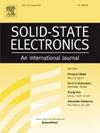通过掺杂和等离子体处理提高p型SnOx薄膜晶体管的迁移率
IF 1.4
4区 物理与天体物理
Q3 ENGINEERING, ELECTRICAL & ELECTRONIC
引用次数: 0
摘要
p型半导体不像n型半导体那么常见,而且它们的性能往往落后于n型半导体,这阻碍了电子设备的效率。在这项研究中,我们展示了一种结合铝(Al)掺杂和氢等离子体处理的两步方法来提高氧化锡薄膜晶体管(TFTs)的性能。Al掺杂显著提高了SnOx薄膜的场效应迁移率,而氢等离子体处理使其向p型电导率过渡。制备的p型掺铝SnOx tft的阈值电压为- 5.2 V,场效应迁移率为1.17 cm2/V·s,离子/离合度为105。这项工作为优化p型SnOx半导体的性能提供了一种新的策略,有助于低功耗互补金属氧化物半导体(CMOS)技术的发展。本文章由计算机程序翻译,如有差异,请以英文原文为准。
Enhancing the mobility of p-type SnOx thin-film transistors through doping and plasma treatment
P-type semiconductors are less common than their n-type counterparts, and their performance often lags in comparison, which hinders the efficiency of electronic devices. In this study, we demonstrate a two-step approach to enhance the performance of tin oxide based thin-film transistors (TFTs) by combining aluminum (Al) doping and hydrogen plasma treatment. The Al doping significantly enhanced the field-effect mobility of the SnOx films, while the hydrogen plasma treatment enabled the transition to p-type conductivity. The fabricated p-type Al-doped SnOx TFTs exhibited a threshold voltage of −5.2 V, a field-effect mobility of 1.17 cm2/V·s, and Ion/Ioff of 105. This work provides a novel strategy for optimizing the performance of p-type SnOx semiconductors, contributing to the development of low-power complementary metal-oxide semiconductor (CMOS) technologies.
求助全文
通过发布文献求助,成功后即可免费获取论文全文。
去求助
来源期刊

Solid-state Electronics
物理-工程:电子与电气
CiteScore
3.00
自引率
5.90%
发文量
212
审稿时长
3 months
期刊介绍:
It is the aim of this journal to bring together in one publication outstanding papers reporting new and original work in the following areas: (1) applications of solid-state physics and technology to electronics and optoelectronics, including theory and device design; (2) optical, electrical, morphological characterization techniques and parameter extraction of devices; (3) fabrication of semiconductor devices, and also device-related materials growth, measurement and evaluation; (4) the physics and modeling of submicron and nanoscale microelectronic and optoelectronic devices, including processing, measurement, and performance evaluation; (5) applications of numerical methods to the modeling and simulation of solid-state devices and processes; and (6) nanoscale electronic and optoelectronic devices, photovoltaics, sensors, and MEMS based on semiconductor and alternative electronic materials; (7) synthesis and electrooptical properties of materials for novel devices.
 求助内容:
求助内容: 应助结果提醒方式:
应助结果提醒方式:


